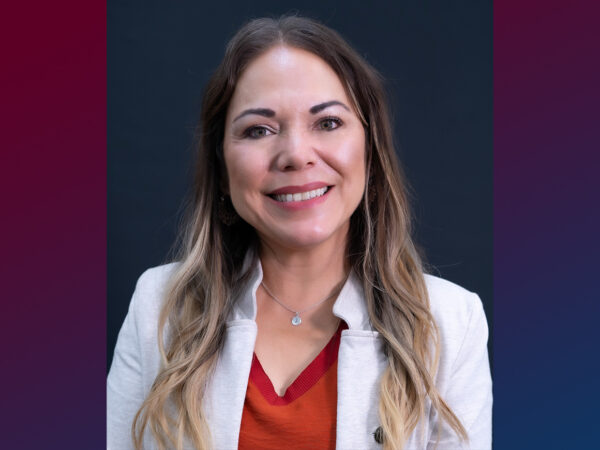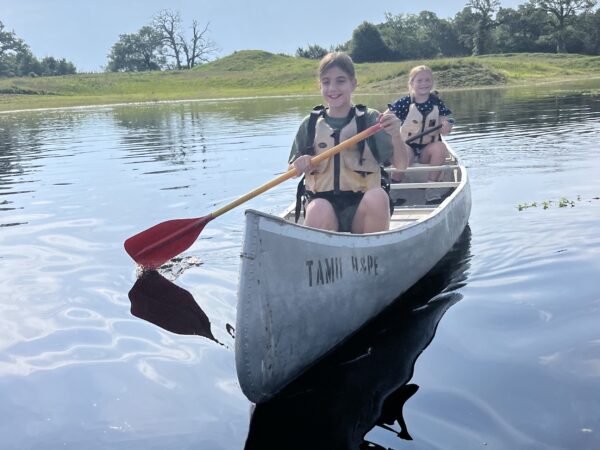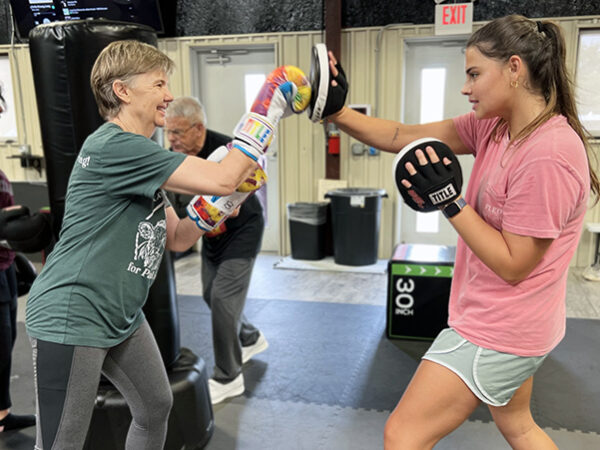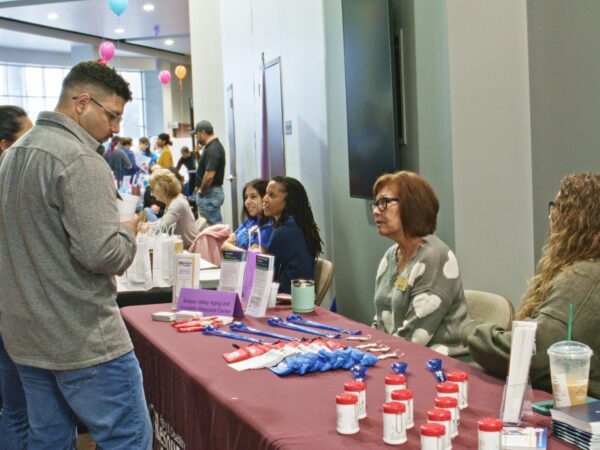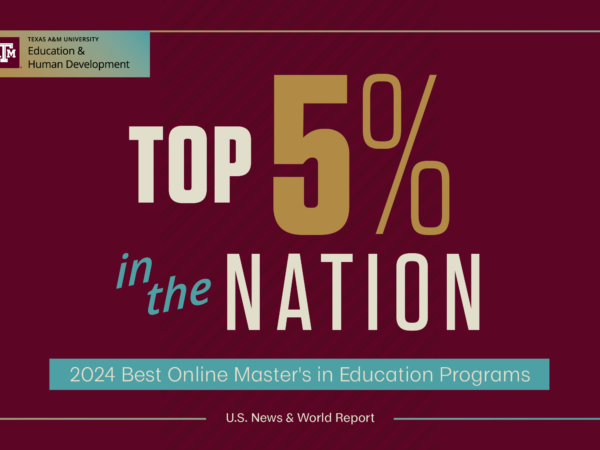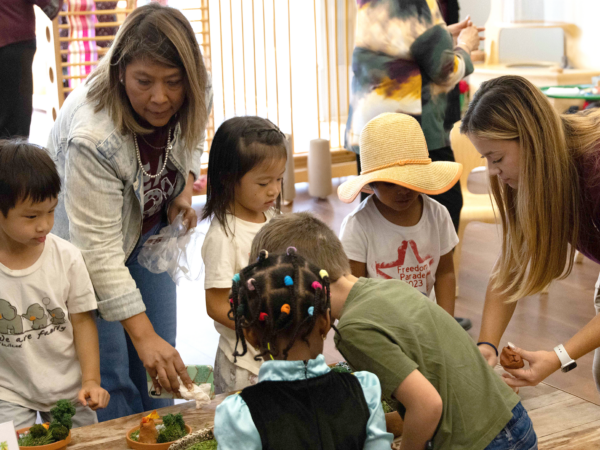Technology in Education
In 2004, the National Council for Accreditation of Teacher Education (NCATE) adopted standards for educators in support of technology integration instruction to enhance student learning. These standards highlighted the importance of empowering future educators with the right resources to teach tomorrow’s technology users.
Drs. Robin Rackley and Radhika Viruru, in the department of Teaching, Learning and Culture, lead the Technology Integration in the Elementary classroom course that introduces pre-service teachers to new technological advances and prepares them to become technology-proficient educators.
Technology can enhance teacher instruction and contribute to a student’s overall learning.
“The class is very important because it focuses on safe and appropriate use of technology integration strategies,” says Viruru. “We found that education students may be comfortable using technology in their daily lives, but are hesitant to integrate it into their teaching practice.”
Overall, the course provides an environment where future educators can experiment, ask questions and measure outcomes. At the end of the semester, students develop lesson plans to effectively integrate technology into their own classrooms. The instructors found that kids with early exposure to technology as students are better prepared for work in the classroom.
“For example, some apps allow teachers to record lessons and students can play them back as necessary. These are great for learning,” says Rackley. “Students record themselves as they work through a problem; the teacher plays back the recording and observes their student’s thought processes as they work through the lesson. For an educator, this is priceless because they may be able to alter instruction to better support student learning,” she says.
One of Robin Rackley’s former students shared her student teaching experience with a classroom of fourth-graders with eight mobile tablets. Using an app like Popplet, student groups produced Web graphs from reading assignments covering the American Revolution. Later, they used the tablets for a science lesson on weather and terrain to collect and organize photos. The technology was easily adapted for use in varying formats across disciplines.
Schools can also benefit from the use of new technologies. “Last year, during a flu epidemic at the school, one of our graduate students made podcasts of her lessons. This really impressed the parents,” says Rackley. “They were able to listen to the podcasts with the children and complete the homework assignments before returning to school. In this example, the podcast turned into a valuable tool for everyone.”
Homebound students and others who are unable to attend traditional classrooms can take advantage of new technologies. Assistive technologies can increase the number of weekly instruction hours that a student receives from his or her teacher. For these students, access to technology and instruction can make a difference in their ability to keep up with assignments or withdrawing from school.
In 2013, Rackley and Viruru introduced students to a VGo robot demonstration. The VGo is a computer-operated robot with a camera display that can be placed in the classroom. With a Wi-Fi connection, homebound students use computer keyboard arrows and a webcam to manipulate the robot around the classroom to be part of the discussion.
Digital learning can create a more inclusive learning environment. For students with special needs, technology can enable them to be more independent and fit in with classroom learning and routines and improve communication skills and learning.
In the Autism, Assessment, Research and Intervention Clinic, a partnership between the college’s Center on Disability and Development and Easter Seals of Texas, associate professor Jennifer Ganz and other researchers have implemented several augmentative and alternative communication (AAC) devices to help children with speech and language disabilities express their thoughts and emotions. Studies indicate that more than 60 percent of children with autism are unable to communicate their needs, wants and thoughts verbally.
In the local Bryan clinic, iPads and AAC apps are part of daily lessons and used as training aids. The clinic saw success of such strategies for a young child with autism when a therapist using an AAC app taught the child to speak in sentences by viewing pictures and listening to the device ‘say’ the words.
Ganz and Dr. Mandy Rispoli, assistant professor of special education, hope to research and develop apps for children with autism and other disabilities.
There is still debate among educators on the appropriate use of technology in the classroom, but many educators who are adopting technology consider mobile devices as valuable resources to enhance students’ learning in and out of the classroom.
For more information:
- Robin Rackley, rrackley@tamu.edu or
- Radhika Viruru, viruru@tamu.edu
The instructors found that kids with early exposure to technology as students are better prepared for work in the classroom.
IPADS CREATE MORE STUDENT ENGAGEMENT IN CLASSROOMS
Although the university will always remain a place where people gather, Dennie Smith, professor of culture, curriculum and instruction in the department of Teaching, Learning and Culture, believes technology like the iPad and other tablets have altered what happens in classrooms.
For three years, students in Smith’s freshman-level multicultural education classes have been assigned iPads for use in the classroom and personal use. Students use the iPads in all their classes with other professors who are becoming more receptive to new technologies.
Smith steered away from a traditional textbook and organized his course using only web resources, iTunes U and other material available online.
“This kind of technology is so ever-present,” says Smith. “As educators, we have to begin implementing it more in what we do and the way we do things.” In fact, this technology is an essential tool for learning and communicating in schools and future workplaces.
The students use the tablets as an interactive learning tool to find relevant scholarly articles, identify unfamiliar terms, take notes and – as part of a final project in the class – gather interviews to create videos.
“I’m used to going into the classroom to lecture, explain, give tests and grade papers,” says Smith. “With the iPad, I’ve created a tension for myself. I’m no longer the source of all knowledge; students have the source in front of them and can access it at any time and any place.”
Students can search and find information instantly to solve problems or learn how to do something. “In fact, one of the students raised the question, ‘why do I have to memorize something if I can find it through Google?’” adds Smith.
As Smith lectures, students are engaged in ‘in-the-moment learning,’ searching for resources on new subjects during class.
“This kind of technology is so ever-present.” says Smith. “As educators, we have to begin implementing it more in what we do and the way we do things.”
“If I tell you something, you may or may not remember it,” says Smith. “But, if you look it up and you are puzzled enough – you will remember that information.”
Smith believes the students learn to use the technology better as a resource as the class progresses. The students are more confident and eager to engage in dialogue by the end of the course, which Smith attributes to the use of iPads.
Of course, students may be more comfortable and engaged because of Smith’s experience with the iPads. His role as a professor has dramatically changed in the way he prepares for class and by behavior in class. However, if teachers try to use the iPads to enhance a top down or presentation mode, then the results with students may be mixed. “The magic of students finding a new app to enhance their learning becomes a constant treasure hunt,” he says.
Smith and a team of graduate students conducted research on the use of iPads in the class. They found that students were more likely to use iPads or tablets for educational purposes and teachers were more confident and competent in using technology to improve their learning, too.
“Technology like the iPad is changing the way we do things, including the manner in which our classrooms function,” says Smith. “My purpose is to bring students together to help them become problem solvers, not just to lecture to them. The iPad helps facilitate this.” Smith explains that facilitating the process of students finding data and building a case for a good solution places the emphasis on finding, evaluating and using information, and these skills are essential for the 21st century workplace.
Classrooms, like brick and mortar businesses, are transforming and technology “enables learning of just about any thing, any time and place,” says Smith.
Smith believes that we bring students together to engage in problem-solving, research and to enhance social collaborations. “The excitement of learning in these classrooms is motivating to both professors and students through increased engagement.”
To see an interview with Dr. Smith on the use of iPads in his course, visit bit.ly/ipadinteractivelearning
KATE VIRTUAL LEARNING: UNIQUE ENVIRONMENT FOR PRE-SERVICE MATH TEACHERS
Firefighters, airline pilots and professional drivers test their abilities using simulation technology and pre-service math teachers in the College of Education and Human Development can test their abilities and train for real-world classroom scenarios in a virtual-learning environment.
Since 2010, the Knowledge for Algebra Teaching for Equity (KATE) project has enriched STEM teacher education by using emergent technology to provide early teaching experiences in a simulated classroom environment.
Many math teachers recognize the need for better teacher preparation and innovative ways to keep a classroom full of diverse learners fully engaged and improve math achievement.
To address these concerns and better prepare pre-service math teachers, an interdisciplinary team of professors in the college initiated the KATE Project with funding from the National Science Foundation. The KATE research team includes Gerald Kulm, Trina Davis, Donald Allen, Kathryn McKenzie and Chance Lewis.
“The KATE Project focuses specifically on problem-solving in algebra for equity, in a highly interactive and engaging learning environment,” says Davis. The project also focuses on developing mathematical knowledge for teaching and addressing the challenges of a diverse student population.
Davis is an assistant mathematics education professor in the college and serves as co-principal investigator for the KATE Project. Since its inception, she has designed and taught the Second Life® class sessions for the project.
Second Life® is an online 3D virtual world for users to socialize, connect and create using avatars and designed communities. Davis worked with her design team to advance the programming and scripting by designing a virtual online teaching environment within Second Life® called the KATE Virtual Lab Classroom on Glasscock Island. “Our Second Life® classroom enables us to help guide pre-service teachers through practice teaching simulations with middle school student avatars,” explains Davis.
They created a classroom to support features for practice teaching lessons and classroom instruction strategies. Tools inside the virtual classroom, such as easels, audio options and media screens display content from interactive SMART Boards.
Pre-service teachers implement and work out math problems on a Smart Podium that appears in real time in the 3D KATE classroom in Second Life®. Students in the redesigned course receive an orientation of how to use Second Life®, then set up a teacher avatar to use for the remainder of the course.
In six class sessions, pre-service teachers simulate teaching math using lessons they created. In the virtual classroom, students practice teaching to middle school student avatars–some are scripted agents controlled by computer programs and role-playing graduate students, who are KATE project team members, control other avatars.
The graduate students conduct research and enact varying learning skills to challenge teacher avatars. Questions on a gesture menu indicate to teacher avatars the student’s level of understanding.
Pre-service teachers can practice communicating in front of a small group of students conducting math tutoring by using their teacher avatars to simulate their actions in Second Life®. These simulations make it possible for pre-service teachers to participate in a more intensive and focused practice as they address the math misconceptions of middle school student avatars.
“By integrating conceptual schemes that address culturally relevant or situated learning, pre-service teachers are better able to engage diverse students in learning algebra,” adds Davis. By the end of the course, pre-service teachers are usually able to teach a full classroom of student avatars.
The KATE Project Virtual Lab Classroom represents a diverse learning environment with student avatars from different backgrounds and learning capabilities to demonstrate what a broad sense of equity looks like in a classroom.
To address achievement gaps in mathematics, I think we need to continue to look for new ways to prepare pre-service teachers.
Davis is excited about the future of the KATE Project and the importance for implementing more innovative technology resources to try to close the math achievement gap for K-12 students. “To address achievement gaps in mathematics, I think we need to continue to look for new ways to prepare pre-service teachers. As long as we continue to see areas of improvement in math achievement, there is a need to research new and emerging approaches.”
For more information:
- Trina Davis at trinadavis@tamu.edu
- kate.tamu.edu
For media inquiries, contact our Media Relations Coordinator, Ashley Green.
Fundraising
To learn more about how you can assist in fundraising, contact Amy Hurley, Director of Development ahurley@txamfoundation.com or 979-847-9455.


